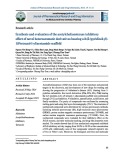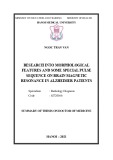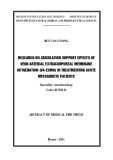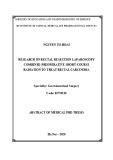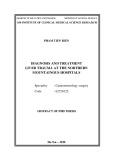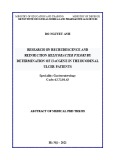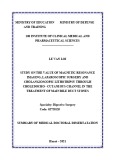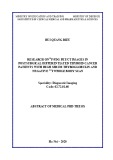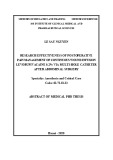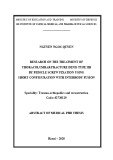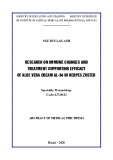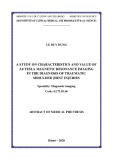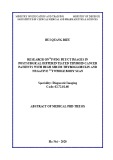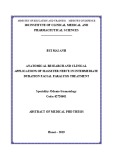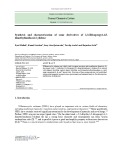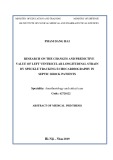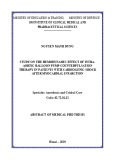MINISTRY OF EDUCATION AND TRAINING MINISTRY OF DEFENCE
108 INSTITUTE OF CLINICAL MEDICAL AND PHARMACEUTICAL SCIENCES
------------------------------------------------- LE DUY DUNG A STUDY ON CHARACTERISTICS AND VALUE OF 3.0 TESLA MAGNETIC RESONANCE IMAGING IN THE DIAGNOSIS OF TRAUMATIC SHOULDER JOINT INJURIES Speciality: Diagnostic imaging
Code: 62.72.01.66
ABSTRACT OF MEDICAL PHD THESIS
Hanoi – 2020
THE THESIS WAS DONE IN: 108 INSTITUTE OF CLINICAL MEDICAL AND PHARMACEUTICAL SCIENCES
Supervisor:
1. Ass. Prof. PhD. Lam Khanh 2. Ass. Prof. PhD. Le Van Doan
Reviewer:
1. 2. 3.
This thesis will be presented at Institute Council at: 108 Institute of Clinical Medical and Pharmaceutical Sciences Day Month Year The thesis can be found at:
1. National Library of Vietnam 2. Library of 108 Institute of Clinical Medical and Pharmaceutical Sciences
1
INTRODUCTION
The shoulder joint is a large, flexible joint that often suffers
from trauma.
In the US, Zacchilli et al (2010) studied 8,940 patients, showing that the rate of shoulder joint injury is 23.9 / 100,000 people. According to Bui Van Duc (2004), evaluated over 8056BN, the rate of shoulder joint injury accounts for 45.0%. Common traumatic shoulder joint disease is a rotating cuff lesion, labrum. Clinical examination is difficult to fully and fully assess lesions. Magnetic resonance imaging (MRI) of the shoulder joint has many advantages compared with each other diagnostic imaging methods, especially high-magnetic field machines such as 1.5 - 3.0 Tesla and magnetic resonance arthrography (MRA) contrast media. According to Lambert.A et al (2009), 3.0T MRI is valuable in assessing small lesions and has a higher accuracy for surgical planning. According to Magnee.T (2015), 3.0 Tesla MRI and MRA are very useful in preoperative evaluation. In Vietnam, there is currently no domestic research on
shoulder joint injury with 3.0 Tesla MRI machines.
That is why we performed the thesis "A study on imaging characteristics and value of 3.0 Tesla magnetic resonance in the diagnosis of traumatic shoulder joint injuries” with two following objectives: 1. Studying on charactistics of 3.0 Tesla magnetic resonance imaging in evaluating some shoulder joint injuries lesions due to trauma. 2. Comment on the value of magnetic resonance and magnetic resonance arthrography in the diagnosis of traumatic shoulder joint injuries compared with surgery.
2 Chapter 1: OVERVIEW
1.1. Shoulder joint anatomy
The anatomical structure of the shoulder joint consists of
active and passive holding elements. Rotator cuff tendons, labrum and
ligaments around the joint are closely related to the image of traumatic
shoulder joint injuries on MRI.
1.3. Diagnostic imaging of the shoulder joint
Diagnostic imaging of the shoulder joint includes X-ray,
ultrasound, computed tomography, magnetic resonance imaging and
diagnostic shoulder arthroscopy. In which, MRI is an effective and
non-invasive method.
1.4. Shoulder joint MRI
Bursae, ligaments, tendons of muscles and labrum have low
signals on all pulses, determined by the anatomic site. The basic
magnetic resonance sections include transverse, vertical, and vertical
sections to ensure that they cut through the shoulder joint.
1.4.4. Image of the labrum on MRI
On the magnetic resonance of the labrum clearly visible on
the horizontal and cross vertical images, characterized by moderate
signal reduction on all pulse sequences, there is a triangle or a wedge-
shaped shape between two strong suppressor structures of the head
humerus and glenoid cartilage.
1.4.5. Image of the rotator cuff tendons on MRI
The rotator cuff tendons has a low signal on all pulse
sequences on MRI. The rotator cuff evaluation consists of 4 muscle
tendons: supraspinatus, infraspinatus, subscapularis and teres minor,
accompanied by a long head with biceps tendon characteristics with
trajectory, shoreline based on anatomy and examination of slice layers
3
1.5. Some lesions of shoulder joint injury on MRI
1.5.1. Rotator cuff lesions
Rotator cuff lesions include partial tear lesions, complete
tears, inflammation and degenerative tendon muscle.
1.5.2. Labrum lesions
On MRI, the labrum is clearly seen in transverse and coronal
plan and moderate signal reduction on all pulse sequences.
1.5.2.1. Bankart lesions
Bankart lesions are the lesion of labrum from anterior to
lower, usually from 3 o'clock to 6 o'clock (and often combine with
Hill-Sachs lesion), this is considered to be basic and common most in
recurrent shoulder dislocation. 1.5.2.2. Labrum defects
A congenital glenoid labrum variant where the anterosuperior
labrum is absent in the 1-3 o'clock position and the middle
glenohumeral ligament is thickened (Buford complex).
1.5.3. SLAP lesion ( Superior Labral Anterior to Posterior lesion)
Lesions of the labrum and biceps tendons at the site sticking
to the edge of the glenoid, the front to the back lesions, limited from
10 -14 o'clock with or without tearing the biceps tendon.
1.5.5. Ligament and capsular lesions
Many studies show that the tendon lesions of the rotator cuffs,
labrum often has other lesions such as ligaments and capsular,
especialy with Bankart lesions.
1.6. Outline of shoulder joint treatments
1.6.1 Conservative treatment Conservative treatment with analgesic, anti-inflammatory drugs or injecting corticosteroids into the subacromial space can
4 provide good results for patients with early rotator cuff tear and mild lesions. Strength excercise helps a lot for patients with non-traumatic shoulder dislocations, pediatric patients, and patients with intentional instability. 1.6.2 Surgical treatment
Some authors have compared the results of conservative treatment with rotator cuff tear fixation and labrum surgery, showing that the surgical method offers better results in terms of motor recovery, muscle strength and joint stability. Nowadays, laparoscopic surgery is commonly used. 1.7. The situation of shoulder joint resonance studies 1.7.1. Foreign research situation Shoulder-joint imaging was performed immediately after magnetic resonance imaging was used in medicine. In 1986, Michaen B and Zlatkin were the first to have a shoulder joint scan of a cadaver. In 1992, Fritts HM studied the image of MRI shoulder joint. In 1994, Tirman studied spontaneous tendon and labrum injuries due to trauma on MRI. Research by Richard Kijowski et al (2009), 3.0T magnetic resonance increases the ability to diagnose knee cartilage damage compared with 1.5T sewing. According to Lambert.A et al (2009), conclude MRI 3.0T is valuable in detecting small lesions. According to Thomas Magee (2009), MRI joint injection increases the sensitivity to detect semi-surface tear lesions of the tendon joints on the spine, tear cartilage anterior border and SLAP lesions better than on 3.0T. 1.7.2. Researches in domestic Although studies abroad are quite rich about shoulder joint injuries due to trauma on MRI. However, in Vietnam, there are still very few studies on images of MR of general shoulder joint lesions and shoulder joint due to trauma in particular, most of the domestic studies often use low-field magnetic resonators and the number of patients is few.
5
Chapter 2
SUBJECTS AND METHODS
2.1. Studying subjects
154 patients with shoulder joint injury were taken by 3.0 Tesla
MRI at the Department of Diagnostic Imaging, 108 Military Central
Hospital from December 2012 to September 2017.
2.1.1. Selection criteria for study patients
Including patients with shoulder joint injury, have enough film were perform on 3.0T MRI. The group of patients undergoing surgery has sufficient medical records.
2.1.2. Exclusion criteria
The patient has no injury, lack of imagings and medical records.
2.2. Reseach method
2.2.1. Study Design
Research method prospective, cross-sectional description with comparison, calculation of diagnostic validity. The assessment consists of two parts: + Part 1: Characteristic description of lesions on MRI. + Part 2: Calculate the value of MRI compared with surgery. 2.2.2 Sample size
Applying the formula for calculating the sample size in the Cross-sectional study we have n = 143 patients. We have taken data on 154 patients in accordance with selection criteria. 2.2.3. Study devices
MR machine includes 2 systems: Gyroscan Achieva 3.0T of
Phillip-Netherlands and Discovery MR750w 3.0T of GE-USA. 2.2.4. Magnetic resonance imaging protocol technique
MRI shoulder joint technique with 3 basic plan and depends on the magnetic field, as well as the lesions to be found.
6 - Patient's position: lying on suppine, hands lying down and on suppine or in ABER position (Abduction External Rotation). The shoulder joint puts in dedicated coils. - 2-4mm thickness, 0.3 mm GAP, 256 x 256 matrix, 12-16 cm FOV cover all shoulder joints. The basic series of pulses sequences include: + T1W fat suppressed spin-echo (TR / TE 400-800 / 8-20 ms). + T2W fast spin-echo (TR / TE 3000-4200 / 90-120 ms). + Proton (PD) density (TR / TE 2200-3000 / 20-30 ms). * Technique for contrast media injection of arthrography
Joint injection was carried out under fluorography guides or
based on anatomical landmarks in a number of 39 patients.
Needle size 20-22G. The injection solution is a mixture mixed with 0.1ml of gadolium, 5ml of contrast fluid + 5ml of lidocaine 1% + 10 ml of 0.9% NaCl when injected under the fluorography or 0.1ml gadolium injection solution and 5ml of lidocaine mixed with 10 -15 ml of 0.9% NaCl when injected according to anatomical landmarks. Injection volume 12-20ml, average 15ml. Perform MRI and evaluate images on workstation. 2.2.5. Research variables Patients were studied according to a uniform medical record format, including the following research variables: 2.2.5.1. Common variables for the study groups - Age group: < 20 y.o, 20-39 y.o, 40-59 y.o and ≥ 60 y.o - Gender: Male và Female - Injury position: right, left shoulder, both sides. - Causes include: traffic accident, sports, daily life, labor, continuous micro-injury and other causes. - The time from the injury to the examination: <6 weeks (42 days); From 6 weeks to <3 months (42 days - <90 days); From 3 months to 6 months (from 90-180 days); > 6 months (over 180 days)
7
2.2.5.2. Clinical evaluation variables for shoulder joint injuries - Symptoms: pain, swelling, limited movement, fear of the dislocation, number of times of the dislocation, other symptoms. - Clinical diagnosis:
+ Limit active and passive movement. + Moving exam and doing exercises including Palm-up or Speed test, Neer, Lift-off, Jobe, Hawkins, Belly-press. + Other symptoms.
2.2.5.3. The variables for assessment of the shoulder joint injury lesion on MRI and MR arthrography. - Labrum lesion: + Changes in signal, morphology and with or without tear lines, divided into 4 categories from I - IV and Bankart lesions. + Divided into 6 positions including: above, front above, front below, below, after above, after below or 4 positions: front above, before below, after above, after below. + Bankart lesions: Bankart, bony Bankart and variant. + Hill-Sachs lesion. + SLAP lesions with 4 types according to Snyder:
- Type 1: Degeneration and fraying of the superior labrum. - Type 2: Avulsion of the superior labrum and biceps anchor - Type 3: Interiorly displaced bucket-handle tear of the superior labrum. - Type 4: Extension of type 3 to involve the biceps anchor
Stage 1: proximal stump near the bony insertion Stage2: proximal stump is at the level of the humeral head Stage 3: proximal stump at the level of glenoid or more
+ Combination and other lesions. - Rotator cuff tears: + Partial thickness: - According to Ellman (1990) and Habermayer (2013) - Position: Articular surface, Bursal surface, center. + Complete tear or not complete tear. + Tendon retraction in complete tear: - According to Patte classification: - According to Bateman classification: Grade 1: tear < 1cm after debridement Grade 2: tear 1-3 cm afterdebridement Grade 3: tear < 5 cm
8
Grade 4: global tear, no cuff left + Degenerative fat rotator cuff include the following categories:
- According to Goutallier from 0 - 4 grades: Grade 0: normal muscle; Grade 1: some fatty streaks; Grade 2: less than 50% fatty muscal atrophy; Grade 3: 50% fatty muscal atrophy; Grade 4: greater than 50% fatty muscal atrophy.
-According to Warner, from degrees 0 – 3 grades: Grade 0: normal muscle; Grade 1: mild, there are several bands of fat in the muscle; Grade 2: moderate, fat accounts for <50% muscle; Grade 3: severity, fat percentage accounts for> 50% muscle.
- According to Thomazeau from degrees 1 to 3, including:
stage 1: normal muscle or slight atrophy when 1.0 + Labrum lesions include location, morphology.
+ Rotator cuff lesions include position, tear morphology, retraction grade, fatty degeneration. + Humeral head such as dislocaton, fracture, edema.
+ Subacrominal space.
+ Bursary and synovial such as effusion, inflammation, etc.. 2.2.6. Methods of data collection and processing
2.2.6.1. The method of data collection
Using sample medical records, taking information from
medical records, imaging of MRI of all qualified patients, from
12/2012 to 9/2017. The study was conducted at 108 Military Central Hospital, on
patients with injuries, the research process did not affect the progress
of treatment, did not pose a risk of harm to the patient. Patient
information is confidential. 2.2.6.2. Data processing Data are entered and processed using SPSS software (V.22) to statistic parameters.
+ Variables of image characteristics are calculated in percentage (%).
+ The variables of values MRI compared with surgery.
Table 2.1: Table of 2 x 2 statistical values Surgical (+)
a
c
a+c Surgical (-)
b
d
b+d Total
a+b
c+d
a+b+c+d MRI (+)
MRI (-)
Total - Calculate sensitivity (Sn), specificity (Sp), accuracy (Acc), positive predictive value (PPV), negative predictive value (NPV) according to the formula. - Calculate the compatibility coefficient diagnosed by Kappa coefficient. Table 2.2: Significance of diagnostic appropriateness of the Kappa value Kappa index
< 0,20
0,20 – 0,40
0,41 – 0,60
0,61 – 0,80
0,81 – 1,00 Suitability
poor
fair
moderate
good
excellent 2.2.7. Research conducted diagram The research was conducted objectively and honestly at a
reputable professional and training institution known as Military Central
Hospital 108. With the voluntary cooperation of research subjects,
relevant information was kept confidential. confidential. Research is only
aimed at protecting and enhancing public health and not for other
purposes. Chapter 3 RESEARCH RESULTS 3.1. Common characteristics of the research team
- The rate of male / female is 70.8% / 29.2% (Male/Female 2,4 times).
- Right / left shoulder 72.7% / 27.3% (right/ left 2.7 times).
- Average age 47,5 ± 15,5 y.o, dislocation group 29,2 ± 9,3 y.o, non-
dislocation age 53,5 ± 12,0. The most common age group 40-60 years
old accounts for 45.5%.
- Cause of injury: Traffic accidents 32.5%, living accident 27.3%,
sports accident 26.6%, labor accident 5.2%, micro injury continuous
8.4%, other causes 0.0%.
3.2. Image characteristics on MRI of shoulder joint injuries
3.2.1. Classify patients by surgery or non-surgery group Table 3.1: Number of patients by surgery and arthrography
Group Non surgery
(n = 57) Total
(n = 154) Surgery
(n = 97) No. of
patients Percent
(%) No. of
patients Percent
(%) No. of
patients Percent
(%) 25
72 25,8
74,2 14
43 75,0
25,0 39
115 25,3
74,7 MRA
Yes
No
p > 0,05 No. of
patients No. of
patients No. of
patients < 0,01
Comments: there were 39 patients with joint injection, accounting for
25.3%, of which 25 patients had surgery.
3.2.2. MRI characteristics by surgical and non-surgical group
3.2.2.1. Result of MRI partial rotator cuff tear Group Table 3.2: Results of partial rotator cuff tear
Surgery
(n = 97) Non-surgical
(n = 57) Total
(n = 154) Partial tear 28
2 28,9
2,1 18
0 31,6
0,0 46
2 29,9
1,3 Tear 1,8
0,0
0,0
1,8
0,0
0,0
35,1
64,9 4
0
1
2
2
2
60
94 2,6
0,0
0,6
1,3
1,3
1,3
38,3
61,7 3
0
1
1
2
2
40
57 1
0
0
1
0
0
20
37 > 0,05 Comment: Partial tear on the muscle tendon on the spine most encountered 29.9%. 3.2.2.2. Result of MRI complete rotator cuff tear No. of
patients No. of
patients No. of
patients Group Table 3.3: Results of complete rotator cuff tear
Non-surgical
Surgery
(n = 57)
(n = 97) Total
(n = 154) Complete tear Tear 3
0
0
0
3
0
2
0
8 26
0
1
0
4
1
6
0
38 23
0
1
0
1
1
4
0
30 5,3
0,0
0,0
0,0
5,3
0,0
3,5
0,0
14,0
86,0 16,9
0,0
0,6
0,0
2,6
0,6
3,9
0,0
24,7
75,3 23,7
0,0
1,0
0,0
1,0
1,0
4,1
0,0
30,9
69,1 49 116 Comment: Supraspinatus complete tear is the most common 16.9%. 3.2.2.9. Results of the rotator cuff tendonitis on MRI Table 3.4: Characteristics of rotator cuff tendonitis No. of
patients No. of
patients No. of
patients Group Surgery Non-surgery Total Percent
(%) Percent
(%) Percent
(%) 26
50
0
0
1
12
8
97 26,8
51,5
0,0
0,0
1,0
12,4
8,2
100 16
23
1
1
0
11
5
57 28,1
40,4
1,8
1,8
0,0
19,3
8,8
100 42
73
1
1
1
33
13
154 27,3
47,4
0,6
0,6
0,6
21,4
8,4
100 Position
tendonitis
Non
Supra.
Infra.
Scap.
Biceps
2 tendons
≥ 3 tendons
Total
p > 0,05 < 0,01 Comment: The most common tendonitis is supraspinatus (47.4%)
3.2.2.10 Image characteristics of fat degeneration on MRI Figure 3.1: Percentage of patients with fatty degeneration
Comments: The number of patients with mild fat degeneration
accounts for the most according to the classification.
3.2.2.12. Bankart lesions Table 3.5: Bankart lesions Group Non-surgery Total Lesions Bankart Labrum
Bony
Variant Surgery
%
n
66,7
24
25,0
9
8,3
3 n
8
3
0 %
72,7
27,3
0,0 n
32
12
3 %
68,1
25,5
6,4 100 47 100 36 < 0,05 Total
p 11
> 0,05
14
25 14
50 Anatomical variant
Total 56,0
100 37,3
100 28
75 28,0
100
Comments: Bankart cartilage damage was the most common,
accounting for 68.1%.
3.2.2.16 Relationship between Hill-Sachs lesions and patients with
dislocation Table 3.6: Relationship between Hill-Sachs lesions and patients with dislocation Dislocation Total Lesion Yes No Hill-
Sachs Yes
No n
34
4
38 (%)
22,1
2,6
24,7 (%)
0,0
75,3
75,3 n
34
120
154 (%)
22,1
77,9
100 Total
p n
0
116
116
< 0,01 Comment: The association between Hill-Sachs and recurrent
dislocation is statistically significant with p <0.01. 3.2.2.17 SLAP lesions Figure 3.2: SLAP injury Comments: SLAP type 2 lesions were the most common (52.2%) 3.2.3. Image characteristics of MRI in arthrography patients 3.2.3.1. The rotator cuff tear in patients with arthrography Table 3.27: Distribution of patients with rotator cuff lesions in the arthrogaphy group Rotator cuff
tear Partial tear Complete tear Tendon lesion
Yes
No
No tear
Supra.
Supra.+scap.
Supra.+ Biceps.
Infra.+ scap.
No tear
Supra.
Biceps (n=39)
29
10
24
12
1
1
1
29
7
3 Ratio (%)
74,4
25,6
61,5
30,8
2,6
2,6
2,6
74,4
17,9
7,7 Comment: Partial and complete tear on the supraspinatus were the most commen. 3.2.3.6. Evaluation of labrum lesions in patients with arthrography Table 3.31: Morphology of labrum lesions in the arthrography group Patient p Lesion < 0,05 Type < 0,05 Bankart
lesions Type 1
Type 2
Type 3
Type 4
Bankart cartilage
Bankart bony
Bankart variant
Yes No.of
patients
1
2
5
20
8
4
2
5 Percent
(%)
3,6
7,1
17,9
71,4
57,1
28,6
14,3
12,8 < 0,05 34 87,2 No Anatomical
variant of the
labrum Comment: Type 4 labrum and Bankart cartilage lesion is the most common. Table 3.35: MRI values in the diagnosis rotator cuff lesions Surgery Comparison Total Yes
No Yes
69
0
69 73
24
97 Rotator cuff
lesions on MRI
Total
p
Kappa No
4
24
28
< 0,001
0,90 Comment: Sn 100%, Sp 85,7%, Acc 95,9%, PPV 94,5%, NPV 100%.
3.3.1.2. Partial and complete tendons tear compared to surgery
Table 3.36: Comparison of MRI with surgery in evaluating partial
and complete rotator cuff tear Surgery Comparison Total MRI Yes
No Partial tear Yes
34
1
35 39
58
97 Total
p
Kappa MRI Yes
No Complete tear 27
4
31 30
67
97 Total
p
Kappa No
5
57
62
< 0,001
0,87
3
63
66
< 0,001
0,83 Comments: Partial tear: Sn 97.1%, Sp 91.9%, Acc 93.8%, PPV 87.2%, NPV 98.3%. Completely tear: Sn 87.1%, Sp 95.5%, Acc 92.8%, PPV 90.0%, NPV 94.0%. 3.3.2 Evaluate the appropriateness of MRI compared with surgery in the diagnosis of labrum lesions 3.3.2.1 Value in the assessment of labrum compared with surgery Table 3.37: Evaluation of general labrum lesions Surgery Comparison Total Labrum
lesions Yes
No Yes
69
3
72 71
26
97 Total
p
Kappa No
2
23
25
< 0,001
0,87 Comment:Sn 95,8%, Sp 92,0%,Acc 94,8%, PPV 97,2%, NPV 88,5%.
3.3.2.2 Evaluation the appropriateness of MRI and surgery in
diagnosing Bankart and Hill-Sachs lesions
Table 3.38: Bankart's injury assessment compared with surgery Surgery Comparison Total Bankart Yes
30
2
32 33
64
97 26
2
28 27
70
97 Hill -
Sachs Yes
No
Total
p
Kappa
Yes
No
Total
p
Kappa No
3
62
65
< 0,001
0,88
1
68
69
< 0,001
0,92 Comment: Bankart lesions: Sn 93,8%, Sp 95,4%, Acc 94,8%, PPV
90,9%, NPV 96,9%. Hill-Sachs lesion: Sn 92,9%, Sp 98,6%, Acc
92,8%, PPV 96,3%, NPV 97,1%.
3.3.2.3 Evaluate appropriateness in diagnosis of MRI and surgery in
the diagnosis SLAP lesions
Table 3.39: SLAP lesions compared with surgery
Surgery Comparison Total SLAP Yes
No Yes
46
2
48 52
45
97 Total
p
Kappa No
6
43
49
< 0,001
0,84 Surgery No arthrography Arthrography MRI
Rotator
cuff
lesions 6
1
7 18
54
72 Total
6
19
25 Labrum
lesions 19
2
21 21
51
72 4
0
4 5
20
25 Yes
No
Total
Kappa
Yes
No
Total
Kappa Yes No
0
18
51
3
51
21
0.90
2
49
51
0.87 Total Yes No
0
18
18
1,0
1
20
21
0.87 Comment: o Rotator cuff lesions: Group without arthrography: Sn 85,7%, Sp
100%, Acc 95,8%, PPV 100%, NPV 94,4%. Arthrography group:
Sn 85,7%, Sp 100%, Acc 96,0%, PPV 100%, NPV 94,7%. o Labrum lesions: Group without arthrography: Sn 90,5%, Sp
96,1%, Acc 94,4%, PPV 90,5%, NPV 96,1%. Arthrography group:
Sn 100%, Sp 95,2%, Acc 96,0%, PPV 80,0%, NPV 100%. 3.3.3.2 . Partial and complete tear comparison with surgery
Table 3.41: Comparison of MRI with surgery in evaluating partial and
complete rotator cuff tear lesions Surgery No arthrography Arthrography MRI Partial tear 43
29
72 Total
15
10
25 Complete
tear 45
3
48 48
24
72 18
0
18 19
6
25 Yes
No
Total
Kappa
Yes
No
Total
Kappa Yes No
1
42
25
4
26
46
0.85
3
21
24
0.81 Total Yes No
0
15
9
1
9
16
0.92
1
6
7
0.90 Surgery
MRI Comment:
- Partial tear: Group without arthrography: Sn 91.3%, Sp 96.2%, Acc
93.1%, PPV 97.7%, NPV 86.2%. Arthrography: Sn 93.8%, Sp 100%,
Acc 96.0%, PPV 100%, NPV 90.0%.
- Complete tear: Group without arthrography: Sn 93.8%, Sp 87.5%,
Acc 91.7%, PPV 93.8%, NPV 87.5%. Arthrography: Sn 100%, Sp
85.7%, Acc 96.0%, PPV 94.7%, NPV 100%.
3.3.3.3 Evaluate the compatibility of MRI diagnosis compared with
surgery in diagnosing Bankart, Hill-Sachs, SLAP lesions
Table 3.42: Appropriate diagnosis of Bankart, Hill-Sachs and SLAP
No arthrography
No Arthrography
No Bankart
lesions Yes
20
2
22 Total Yes
10
0
10 23
49
72 Total
10
15
25 17
2
19 18
54
72 9
0
9 9
16
25 Hill-
Sachs
lesions SLAP
lesion 17
2
19 18
54
72 9
0
9 9
16
25 Yes
No
Total
Kappa
Yes
No
Total
Kappa
Yes
No
Total
Kappa 3
47
50
0.84
1
52
53
0.89
1
52
53
0.89 0
15
15
1,0
0
16
16
1,0
0
16
16
1,0 Comment:
- Bankart lesions: Group not arthrography: Sn 90.0%, Sp 94.0%, Acc
93.1%, PPV 87.0%, NPV 95.9%; the group with arthrography all
indicators reached 100%. Hill-Sachs: Group not arthrography: Sn
89.5%, Sp 98.1%, Acc 95.8%, PPV 94.4%, NPV 96.3%; the group
with arthrography all indicators reached 100%. SLAP lesions: Group
not arthrography: Sn 94.4%, Sn 86.1%, Acc 90.3%, PPV 87.2%, NPV
93.9%; arthrography: Sn 100%, Sp 92.3%, Acc 96.0%, PPV 92.3%,
NPV 100%. Chapter 4 DISCUSSION 4.1. General characteristics of the study patients
4.1.1 Distribution of patients by gender and location The ratio of male / female is 2.4 / 1, of which 70.8% are male,
29.2% are female, and it is consistent with other studies such as Phan
Chau Ha (2006), Zacchilli.MA (2010) and David. W. Stoller 2007).
Right / left shoulder ratio is 2.7 times, consistent with studies of Vu
Minh Hai (2015) nearly 4 times, Dang Thi Bich Nguyet (2016) 2.3
times, Kashani et al (2008).
4.1.2. Distribution of patients by age group The most common age group is 40 - 59 y.o, accounting for
45.5%. The mean age was 47.5 ± 15.5y, in the group with the
dislocation 29.2 ± 9.3y, much smaller than the group without
dislocation was 53.5 ± 12.0y, the study results were consistent with
other researches such as Vu Minh Hai (2015), Kashani. S. (2008).
4.1.3 Cause of injury The group of sports, traffic and domestic accidents accounts for
86.4%, similar to the study Vu Minh Hai (2015), Nguyen Trong Anh
(2007).
4.2. Image characteristics of shoulder joint MRI in trauma patients Table 3.4 shows that there are 39 patients with joint injections,
accounting for 25.3%, with 25 patients with surgery and 14 patients
without surgery.
4.2.1 Image characteristics on MRI rotator cuff lesions
4.2.1.1 Image of partial rotator cuff lesion Table 3.5 shows that, the number of patients with partial
tearing accounted for 38.3% with 59 patients, in the surgical group
was 40.2%, with the most common part of the tendon tear on the
supraspinatus tendon, accounting for 29.9%. Our results are consistent Figure 3.6 shows that, tearing the bursal surface is the most
common with 35 patients, accounting for 57.4%, consistent with
research results of Dang Thi Bich Nguyet (2016), tearing the bursal
face, accounting for 60.0%. According to Chun K.A. et al (2010), the
sensitivity and specificity of the diagnosis of partial tearing of the
rotator cuff tendon of the cartilage surface are 85.0% and 90.0%, the
synovial surface is 62.0% and 95.0%, respectively.
* The partial tear scale according to Ellman and Habermeyer follows
Table 3.8. The resolution of Ellman (1987) and Habermayer showed that
the first grade tear was most encountered with 29 patients, accounting
for 48.3%. Correlation between the two grades was very high with
kappa 0.89. The number of patients with partial tear according to the
levels encountered in the surgical group more than the non-surgical
group.
4.2.1.2 Evaluation of complete tear of the rotator cuff tendon Table 3.6 shows that there are 38 patients with complete tear,
accounting for 24.7%, complete tear of the supraspinatus tendons is
the most common, accounting for 68.4%, surgical groups accounting
for 88.5%. Research results are consistent with researchers such as
Dang Thi Bich Nguyet (2016), Do Van Tu (2010). Table 3.10 shows that, completely tear surgical group
accounts for 19.5%, right shoulder position accounts for 20.1%;
according to men, 14.3% and both higher than the other group. The
results showed that the level of muscle tendon contraction according
to Patte and Batterman grade 2 was the most encountered, respectively
42.1% and 47.4%. The retraction grade is related to the ability to
restore the muscle tendons after surgery.
4.2.2. Magnetic resonance the rotator cuff imaging of degeneration fatty The MRI image shows the fat signal in and around the muscles
plus the muscles retraction in size depending on the stage. The
research results in table 3.15 and graph 3.7 show that, in the research
group, severe degeneration is much less common than mild
degeneration according to different levels, consistent with the study of
Klaus Strobel et al (2005).
4.2.3. Tendonitis of the rotator cuff muscles
Tendonitis of the rotator cuff muscles is a condition in which
the tendons lose their uniformity and uniformity in signaling, have a
special uneven increase signal on T2W, PD pulses, unevenly
decreased on T1W PD, increased in size in the acute stage and atrophy
in the chronic stage. This is a nonspecific and reactive inflammatory.
According to Table 3.14, tendonitis was found in most patients,
accounting for 72.7%, of which, tendonitis on supraspinatus muscle
was most common, accounting for 47.4%.
4.2.4 Characteristics of magnetic resonance images labrum lesions
4.2.4.3. Bankart and Hill-Sachs This is a common labrum lesion and is often associated with
Hill-Sachs lesions in recurrent dislocation patients. According to the
results in Table 3.17, Bankart cartilage lesions were found the most,
accounting for 68.1%, followed by bony Bankart with 25.5% and more
in the surgical group. Research results are consistent with authors such
as Do Van Tu (2010), Dang Thi Bich Nguyet (2016), Sheehan S.E
(2013), Horst.K et al (2014). Table 3.21 shows that Hill-Sachs lesions in patients with the
dislocation, accounts for 22.1%, much higher than patients without
dislocation by 0.0% and statistically significant with p <0.05, consistent
with Nguyen Trong Anh (2007), Daniel (1999).
4.2.5. Image characteristics of the magnetic resonance SLAP lesion Figure 8 shows that, SLAP lesions accounted for 43.5%, According to Roy. J.S. et al (2015) in a meta analysis study
showed that, diagnosing MRI and CT with arthrography in the
diagnosis of complete tear of the rotator cuff tendon has both
sensitivity and specificity over 90, 0%; Diagnosis of a partial tear for
the rotator cuff tendon has a specificity of over 90.0%, but a lower
sensitivity of about 67.0 - 83.0%. In our study, the imaging
characteristics results are quite overlapping, similar to the general
visual characteristics of the whole patient group in the study.
4.4. The value of magnetic resonance in the shoulder joint due to
trauma compared with surgery
4.4.1 Evaluate appropriateness in diagnosis of MRI and surgery in the
diagnosis of rotator cuff lesions Table 3.35 shows the sensitivity, specificity, accuracy,
positive predictive value, negative predictive value of MRI in the
evaluation of rotated apical lesions respectively 100%; 85.7%; 95.9%;
94.5% and 100%. Research results in Table 3.36, magnetic resonance
in evaluation of partial tear, complete tearing of the rotator cuff tendon
are consistent with the postoperative assessment, most of which are
over 90.0%, with the coefficient matching diagnosis is above 0.8. Our
research results are consistent with other research results at home and
abroad such as Torstensen F.T et al. (1999), Sharma. G et al (2017).
4.4.2. Evaluation of conformity in diagnosis of MRI and surgery in the
diagnosis of labrum lesions, including Bankart and Hill-Sachs
Values in the diagnosis of labrum lesion, Bankart, Hill- Sachs
according to the research results in Tables 3.37 and 3.38, show that
MRI in the assessment of labrum lesion compared with postoperative The value of resonance from the joint injection compared with
no joint injection in the evaluation of partial tear, complete tear
lesions, according to the research results in Table 3.41, the diagnostic
values were mostly over 90% and had edema coefficient of the
diagnosis is very high, above 0.8. Our results are consistent with the
evaluation and results of the general assessment and consistent with
other domestic and foreign studies such as Lambert. A. et al (2009),
showing that the 3.0T machine gives comment that there is no the
difference between lesions detected on magnetic resonance versus
evaluation on surgery for morphology, lesion size and positive
predictive value result compared to surgery is 100%, of which 100%
with complete tear and 92.0% with partial tear.
4.5.3. Evaluate diagnostic compatibility of MRI with surgery in
diagnosing Bankart, Hill-Sachs and SLAP lesions According to the research results in Tables 3.41 and 3.42, MRI
evaluating lesions of Bankart, Hill-Sachs, SLAP compared with
surgery has almost of all diagnostic values of over 90.0% and has a
very suitable diagnostic coefficient above 0.8. According to the above
research results, all diagnostic values of Bankart, Hill-Sach lesions in
surgical patients with MR arthrography are 100%. Our results are
consistent with the assessment and results of the general assessment
and consistent with other domestic and foreign studies. Thus, the evaluation of shoulder joint injury characteristics by
the rotator cuff tendons, labrum and other components lesions must
carry out clinical examination and use imaging diagnosis to determine.
In particular, atypical lesions require specialist group consultation and
bilateral comparison. In particular, magnetic resonance is a valuable
means of detecting lesions. CONCLUSION Through the study with 154 patients, we have some tear accounted respectively. Completely conclusions:
I/ Image characteristics of shoulder joint injuries on MRI
1.1. Image characteristics of rotator cuff tendon lesions
- Partial tear of the rotator cuff was accounting for 38.3%, the
supraspinatus and bursal surfaces was most encountered 29.9% and
58.3%,
for 24.7%,
supraspinatus tendon was most encountered, accounting for 68.4%.
Mild fat degeneration is most common, with p <0.01. Tendonitis
found in 72.7%, supraspinatus tendonitis was most common with
47.4%.
1.2. Image characteristics of labrum lesions
- The most common lesions of labrum are: type 4, accounting for
70.7%, and in the front and lower positions accounting for 28.1%.
Bankart cartilage the most encountered, accounting for 68.1%. Hill-
Sachs was encountered at 22.1% and related with statistical
significance in patients with recurrent shoulder dislocation with p
<0.05. SLAP lesion accounted for 43.5%, SLAP type 2 was the most
common, accounting for 52.2%.
1.3. Other image characteristics lesions
- The subglenohumeral ligament demage accounts for 42.9%. The
humeral head injury at the tendon attachment point accounts for
59.3%; 58.4% of bone edema met. Acrominal shape with type 1 are
most encountered 64.9%, flat direction accounts for 71.4%. The bursal
demage is found in 88.3% and the sub-acrominoclavical bursae are the
most common, accounting for 57.1%.
1.4. Image characteristics of patients with arthrography
- The lesions of the rotator cuff, labrum and other lesions were similar
to the patient general group studied.
II / The value of magnetic resonance imaging in assessing shoulder
joint lesions in trauma patients comparison with surgical
1.1. Valuable in the diagnosis of rotator cuff lesions - Evaluation of the rotator cuff tendon lesions in general,
partial tear, complete tear, respectively: Sn 100%, 97.1% and 87.1%;
Sp 85.7%, 91.9% and 95.5%; Acc 95.9%, 93.8% and 92.8%; PPV
94.5%, 87.2% and 90.0%; NPV 100%, 98.3% and 94.0%. 1.2. Evaluation of labrum, Bankart and Hill-Sachs lesions - With labrum lesion: Sn 95.8%, Sp 92.0%, PPV 97.2%, NPV 88.5%, Acc 94.8%. - For Bankart, Hill-Sachs and SLAP lesions respectively: Sn
93.8%, 92.9% and 95.8%; Sp 95.4%, 98.6% and 87.8%; Acc 94.8%,
92.8% and 91.8%; PPV 90.9%, 96.3% and 88.5%; NPV 96.9%, 97.1%
and 95.6%.
1.3. Magnetic resonance values by non-arthrography compared with
arthrography - Rotator cuff lesion in the injection compared with no
injection: Sn, Sp PPV are equal to 85.7%; 100%; 100%; Acc 96.0%
and 95.8%; NPV 94.7% and 94.4%. - Partial tear, complete tear in the injection compared with no
injection, respectively: Sn 93.8% and 100% compared with 91.3% and
93.8%; Sp 100% and 85.7% compared with 96.2% and 87.5%; Acc
96.0% and 96.0% compared with 93.1% and 91.7%; PPV 100% and
94.7% compared with 97.7% and 93.8%; NPV 90.0% and 100%
compared with 86.2% and 87.5%. - Labrum lesion in the injection compared with no injection:
Sn 100% and 90.5%; Sp 95.2% and 96.1%; Acc 96.0% and 94.4%;
PPV 80.0% and 90.5%; NPV 100% and 96.1%. - Bankart, Hill-Sachs and SLAP lesion in the injection group
compared with no injection were, respectively: Sn 100%, 100% and
100% compared with 90.0%, 89.5% and 94.4%; Sp 100%, 100% and
92.3% compared with 94.0%, 98.1% and 86.1%; Acc 100%, 100%
and 96.0% compared with 93.1%, 95.8% and 90.3%; PPV 100%,
100% and 92.3% compared with 87.0%, 94.4% and 87.2%; NPV
100%, 100% and 100% compared with 95.9%, 96.3% and 93.9%
Bankart, Hill-Sachs lesion in the injection group have values of 100%
and values in the injection group was higher than the group without
injection. Coefficients of diagnostic compatibility for Kappa in the study were all very high above 0.8. MRI is an effective and valuable means to diagnose and
evaluate shoulder joint injuries in general and in shoulder joint injuries
in particular. PROPOSALS Basing on researched results, we might have some proposals as follow: - For patients with shoulder joint injuries should be taken early magnetic resonance imaging to diagnose when the clinical signs and other images are not clear. - When it is suspected, undiagnosed shoulder lesion on the conventional magnetic resonance, we should better have performed MRA for more information diagnosis, because by very high diagnostic value according to the research results. - Should be clinically combined when evaluating imaging. LIST OF PUBLISHED ARTICLE RELATING TO THESIS 1. Le Duy Dung, Lam Khanh, Le Van Doan (2018), “The studying of 3.0 Tesla magnetic resonance imaging characteristics in finding shoulder joint injury lesions”, Jounal of 108 – Clinical Medicine and Pharmacy, (vol.13), pp. 34-43. 2. Le Duy Dung, Lam Khanh, Le Van Doan, Do Duc Cuong (2018), “Comparision of magnetic resonance imaging and arthroscopy in evaluation of shoulder joint injury lesions”, Jounal of 108 – Clinical Medicine and Pharmacy, (vol.13), pp. 336-343. 3. Le Duy Dung, Lam Khanh, Le Van Doan, Do Duc Cuong (2019), “The evaluation of magnetic resonance arthrography characteristics in finding shoulder joint injury lesions”, Jounal of 108 – Clinical Medicine and Pharmacy, (vol. 14), pp. 78-84.9
10
Patients with shoulder
joint injury to the hospital
Clinical examination,
Indications for taking
MRI
- Rotator
cuff
lesions
- Labrum lesions
- Other lesion
The patient was taken
and injury assessment on
MRI
No hospital admission
Surgery hospital
admission
Surgical results
MRI results
Goal 1
Image
characteristics
Evaluate
- Sensitivity, specificity,
negative predictive value,
positive predictive value
- Appropriateness of
diagnosis
Goal 2
The value of
magnetic
resonance
2.2.8. Research ethics
11
Percent
(%)
Percent
(%)
Percent
(%)
Supra.
Infra.
Scapul.
Teres mi.
Biceps.
Supra+infra
Supra+scap.
Infra+scap.
Total
12
3,1
0,0
1,0
1,0
2,1
2,1
40,2
59,8
No tear
p
Percent
(%)
Percent
(%)
Percent
(%)
Supra.
Infra.
Scapul.
Teres mi.
Biceps.
Supra+infra
Supra+scap.
Infra+scap.
Total
No tear
p
13
14
100
15
16
3.3. The value of shoulder joint MRI lesions compared with surgery
3.3.1.1 Evaluate the appropriateness of MRI compared with surgery
in the diagnosis of rotator cuff lesions
17
18
Comment: Sn 95,8%, Sp 87,8%,Acc 91,8%, PPV 88,5%, NPV 95,6%.
3.3.3 Value and relevance of the diagnosis of MRA
3.3.3.1 Evaluate the diagnostic compatibility of rotator cuff and
labrum lesions compared with surgery
Table 3.40: Assessment of diagnostic compatibility of rotator cuff
and labrum lesions
19
20
21
with the results of other domestic and international studies such as
Dang Thi Bich Nguyet (2016), Phan Chau Ha (2006).
22
23
SLAP type 2 was the most common, accounting for 52.2%, consistent
with research results of other domestic and foreign authors such as
Dang Thi Bich Nguyet (2016), Pham Ngoc Hoa et al (2009), Antonio
(2007).
4.3. Image characteristics MR Arthrography with contrast agent
24
assessment has diagnostic values, most of them are over 90.0%, with
diagnostic relevance coefficients above 0.8. Our results are consistent
with other research results at home and abroad such as Pham Ngoc
Hoa, Ho Ngoc Tu (2009), Waldt.S et al (2005). According to Richard.
K. et al (2009), MRI 3.0T has accuracy of 1.5T higher with p <0.05
and MRI 3.0T increases the diagnostic value of cartilage damage
compared to 1.5 Tesla. According to Magnee. T.H. et al (2006), a
study on 67 patients taking MRI 3.0T with surgical comparison, found
the sensitivity was 86-89.0%, the specificity was 100%.
4.4.3. Values of magnetic resonance in the diagnosis of SLAP lesions
According to Table 3.39, it shows that MRI in diagnosis
SLAP lesion assessment compared with postoperative assessment has
diagnostic values mostly over 90.0%, consistent with the study of
Magnee. T.H. et al (2006). on MRI 3.0T machine with surgical
comparison.
4.5 The value of MRI diagnosis comparison with surgical between
the arthrography and non-arthrography groups
4.5.1. The diagnostic value of MRI compared with surgery between
the arthrography and the non-arthrography group in the diagnosis of
rotator cuff and labrum lesions
According to the results in Table 3.40, showed that MRI in the
assessment of rotator cuff and labrum lesions compared with the
assessment between the arthrography and no arthrography group had
diagnostic values, most of which were over 90.0%. According to the
above study results, all values of specificity and predictive values were
positive in the evaluation of the rotator cuff, and the sensitivity and
predictive value were negative in assessing labrum lesion in patients
with MRA. reach 100%. The difference in the indices between the two
groups injected and the non-injected was almost similar. This may be
due to the small number of patients, prior examination, so the clinical
orientation is already in place. The studies show that MRI for the joint
shows more clearly the lesion and is better evaluated in the cases of
25
partial tear, but the complete tear is usually on the conventional MRI
which has already been evaluated.
4.5.2. Values in evaluation of partial and complete rotator cuff tear
compared with surgery.
26
27
28

